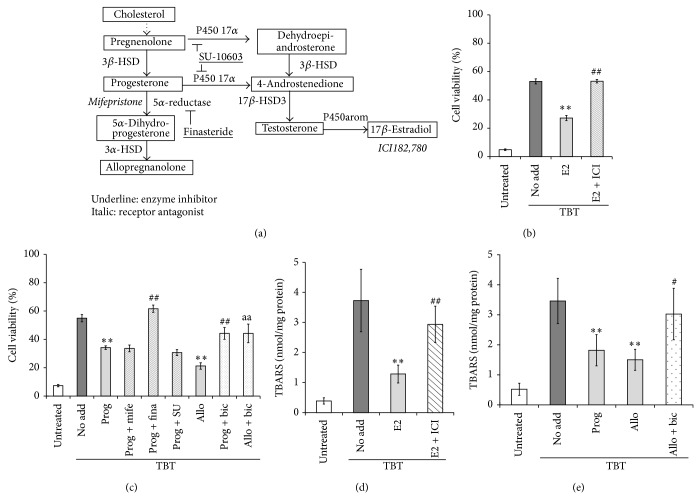Figure 2.
Effects of 17β-estradiol and progesterone on TBT-induced oxidative stress and cell death in rat hippocampal slices. (a) Pathway of steroid hormone metabolism in the rat hippocampus. HSD, hydroxysteroid dehydrogenase. (b, d) Rat hippocampal slices were pretreated with ER antagonist ICI182,780 (ICI, 100 μM) for 20 min, after which 1 μM of 17β-estradiol (E2) was added to the culture. After 6 h of incubation, the slices were treated with 3 μM of TBT for 24 h. Cell viability of the CA1, CA3, and dentate gyrus regions was measured by propidium iodide staining (b), and lipid peroxidation was evaluated by determination of thiobarbituric acid reactive substance (TBARS) content (d). The reported values are the mean ± S.E. of 5 separate experiments. ** P < 0.01 versus 3 μM TBT-treated group. ## P < 0.01 versus 3 μM TBT and 1 μM 17β-estradiol-treated group. (c, e) Rat hippocampal slices were pretreated with progesterone receptor antagonist mifepristone (Mife, 10 μM), 5α-reductase inhibitor finasteride (Fina, 100 μM), cytochrome P450 17α inhibitor SU-10603 (SU, 20 μM), or GABAA receptor antagonist bicuculline (Bic, 100 μM), after which progesterone (Prog, 1 μM) or allopregnanolone (Allo, 1 μM) was added to the culture. After a 2 h incubation, the slices were exposed to 3 μM TBT for 24 h. Cell viability (c) and lipid peroxidation (e) were evaluated. The reported values are the mean ± S.E. of 5 separate experiments. ** P < 0.01 versus 3 μM TBT-treated group. # P < 0.05, ## P < 0.01 versus 3 μM TBT and 1 μM progesterone-treated group. aa P < 0.01 versus 3 μM TBT and 1 μM allopregnanolone-treated group.

